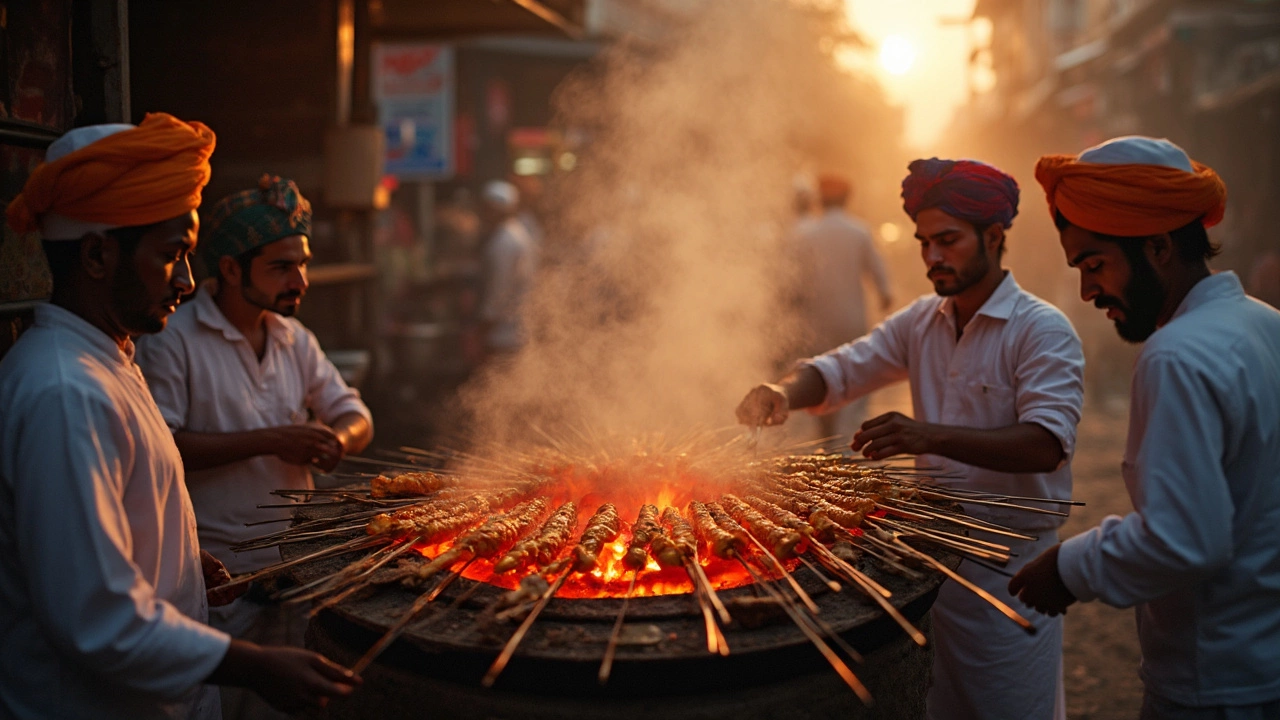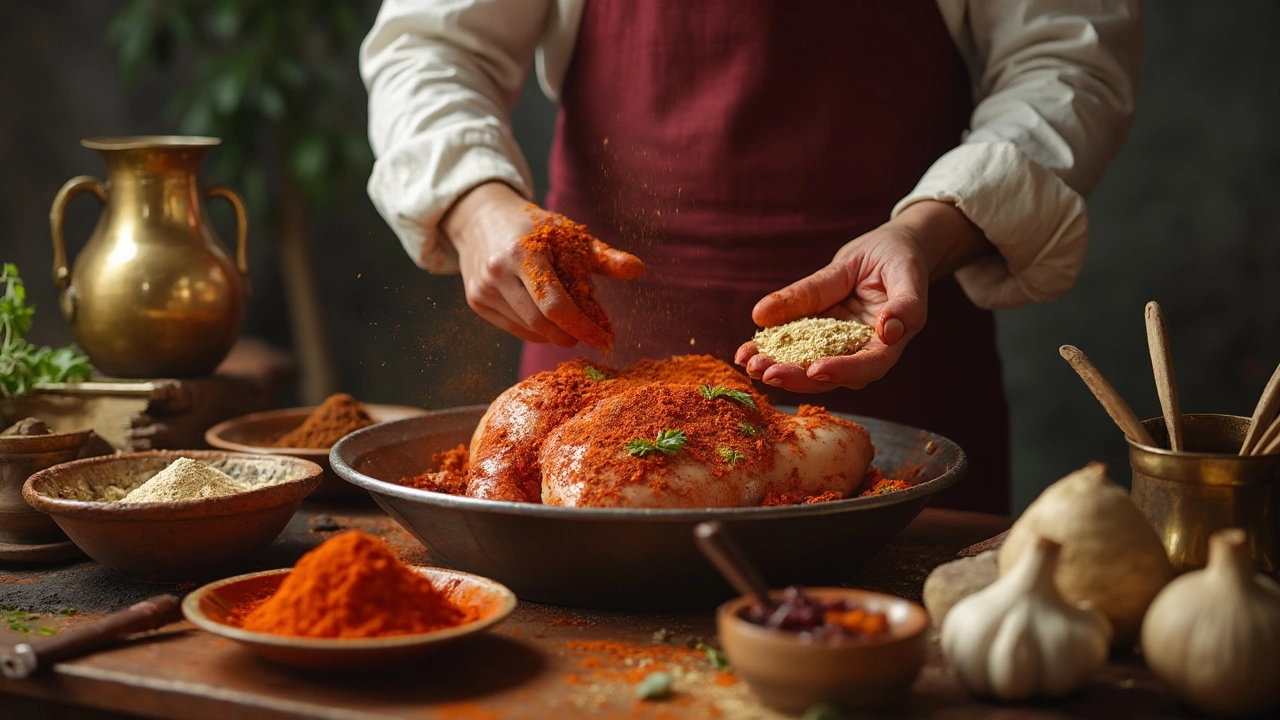Picture this: you walk by an Indian restaurant and peer inside. The smoky aroma of charred meat escapes through the doorway, and out comes that unmistakable plate piled with sizzling red tandoori chicken. The color is more than just eye-catching—it almost dares you to taste it. But have you ever stopped to wonder how it gets that gorgeous, impossible red? Spoiler—it has less to do with the chicken and everything to do with centuries-old culinary wizardry, spice trail accidents, and, sometimes, a splash of food coloring that would surprise even your cat.
The Original Tandoori: From Humble Roots to Culinary Icon
Tandoori chicken didn’t always look the way it does on menus today. The story starts in the Punjab region, sometime in the late 1940s, when the tandoor (a clay oven) was already a part of everyday northern Indian life. Refugee cooks like Kundan Lal Gujral, fleeing the Partition, brought the dish to Delhi and essentially popularized what we now know as tandoori chicken. The iconic look? That came later, as chefs raced to outdo each other with recipes (and, yes, more color).
Back in those earliest kitchens, the chicken was marinated in basic ingredients: yogurt, garlic, ginger, and a few common ground spices. Paprika, cayenne, chili powder, turmeric—the color was an afterthought. The tandoor’s super-hot walls, heating up to a searing 900°F, gave the meat its smoky finish and crusty exterior. The pinkish-red was just a byproduct of the paprika and chili powder in the marinade, boosted by the caramelization process. But here’s where it gets interesting: it wasn’t quite the bright red we see these days. In fact, if you found yourself at a family table in Punjab back then, your tandoori chicken would look pale compared to today's flamboyantly red birds.
Restaurants in the 1970s and ’80s tweaked the recipe for dramatic effect. As tandoori chicken became a global dish, chefs started boosting the red quotient to appeal to Western diners, who expected color to match flavor intensity. That brings us to a surprising twist in the story—the rise of artificial food coloring, which became a kitchen staple in many restaurants in India and abroad. Some tandoori chicken recipes went loud neon red, partly because synthetic dye made the dish stand out in buffet lines and street stalls alike.
Just for fun, check out this stat: a survey by an Indian hospitality magazine in 2018 found that 65% of restaurants used artificial coloring in at least one version of tandoori chicken. Wild, right? But don’t judge them—chefs argue that it’s a harmless tradition, while purists say it’s an abomination. It’s a never-ending debate at food festivals, and honestly, both sides have their points.
Still, at its heart, the real magic of tandoori chicken isn’t about the dye. It’s about how the marinade flavors seep into the meat, react with the high heat of the oven, and end up locking in all the goodness. The signature color? Just an extra reason to snap a photo before digging in. Neko, my cat, probably wouldn’t care about the color, but she would definitely sniff out the roasted aroma.
Spices and Science: What’s Really in the Marinade?
If tandoori chicken’s redness isn’t all about food dye, what are the natural players at work? The answer: a friendly gang of Indian spices and yogurt. Here’s the core cast list—and why they matter for color and flavor.
- Tandoori chicken: Center stage, obviously. Skinless chicken, cut evenly for better marinade penetration.
- Yogurt: Often Greek-style or straining regular yogurt does wonders. Yogurt is slightly acidic, helping tenderize the meat while holding all the spices together in a creamy paste.
- Cayenne pepper: The real boost for red. Cayenne is pretty spicy but also adds that vivid reddish hue.
- Kashmiri red chili powder: This is the go-to for color without too much heat. It shows up in most traditional recipes—think rich brick red, not fire alarm red. It’s milder than cayenne and beloved for its pigment.
- Paprika: Used in some modern recipes for smokiness and tone, not so much for heat. The sweet, earthy flavor comes packaged with a burnt orange-red tint.
- Turmeric: The sneaky one—gives a golden undercurrent rather than red. If you see tandoori chicken that looks a bit orange? Thank turmeric.
- Garlic, ginger, cumin, coriander: For depth and aroma, not so much for color.
Mix those together—especially the Kashmiri chili—and the marinade turns into a striking red paste. Once slathered over the chicken and left to marinate overnight, the acids in the yogurt kickstart the breakdown of proteins, making the meet more tender and juicy. Meanwhile, the color sets into the skin and flesh.
What science says is pretty cool, too. The compounds responsible for the color in Kashmiri chili, called capsanthin and capsorubin, are stable under heat, so they survive the tandoor’s blast and stick around, even after the chicken is cooked through. If you ever see a paler batch, it’s likely missing the good stuff or the marination time was too short.
But, like any good kitchen drama, there’s always a shortcut. When restaurants want their chicken to be extra red, they reach for food dye labeled "Red 40." A little pinch mixed into the marinade goes a long way. (At home, you can cheat the same way, but try beetroot powder for a more natural trick.) Some chefs swear by a mix of both—just enough Kashmiri chili for taste, and a teeny bit of dye for visual pop, especially under harsh restaurant lighting.
If you want the classic red look without artificial colors, here's a tip: sprinkle a bit of beetroot powder or blend up a piece of roasted red bell pepper right into your marinade. Both add rich color and mild earthy sweetness, and they keep things bright without synthetic dyes. My neighbor tried pomegranate powder and swears it's the secret to a glossy finish. There's no single right answer; every chef—and every home cook—has their own color hack.

The Tandoor Effect: How Fire, Clay, and Smoke Intensify the Color
You’d think the color is all about the marinade, but there’s a bigger plot twist. The tandoor oven itself transforms the chicken in a way that your kitchen oven just can’t copy. When chicken goes into a blazing-hot tandoor (which can hit 900°F, or 480°C), a few fun things happen:
- The marinade seals and chars on contact, creating that smoky crust everyone loves.
- The yogurt in the mix caramelizes, amplifying redness and helping the color "set."
- The radiant heat cooks the chicken incredibly fast, so the outside gets dramatic color while the inside stays juicy.
Chemically, the so-called Maillard reaction (which is just a nerdy name for browning that gives meat its flavor) gets supercharged in a tandoor. Sugars and proteins in the marinade break down and recombine in ways that deepen the chicken’s reddish hue. It’s like the difference between toasting bread in your toaster and over an open flame—you’ll always get more color and flavor with that hit of direct heat and smoke.
And don’t forget, actual tandoor cooking almost always makes the final color richer and more dramatic than standard oven baking, so home cooks have to work a little harder for that result. Here’s where the color cheat codes come out—either by slightly upping the proportion of Kashmiri chili in the recipe or, again, borrowing some beet or natural powder for backup. If you own a grill, setting it to its highest temperature and letting the chicken get that charred finish can, at least, get you in the flavor neighborhood.
If you want more numbers (and who doesn’t?), the temperatures inside a tandoor have been measured to average nearly 900°F during peak dinner service hours. Compare that to most household ovens, which max out at around 500°F. The high heat works miracles on both flavor and color. It also roasts the fats and sugars in the marinade, coaxing out earthy, nutty undertones. Food scientists in a 2021 study out of Mumbai actually measured the pigment intensity of tandoori chicken done in tandoors versus electric ovens and found that tandoor-cooked samples scored up to 40% higher in "redness value." If you’re a sucker for a good food chart, here you go:
| Cooking Method | Average Final Color (Redness Value / a*) |
|---|---|
| Tandoor Oven | +40% vs baseline |
| Electric Oven | Baseline |
| Charcoal Grill | +30% vs baseline |
Not only does the tandoor lock in the red hue better, but it also gives the chicken that legendary smoky smell you can’t fake, no matter how many drops of dye you use. Every time I catch that scent drifting down my street, I instantly know someone nearby is firing up the clay oven for something good.
And if you're like me and your curious cat Neko, you'll be at the door waiting for the first bite—color or not.
Tandoori Chicken at Home: Getting the Color Without the Chemicals
Craving tandoori chicken but want to skip artificial colors? You totally can, and it’s easier than you think. Here’s the simplest, most effective guide to turning out beautifully red (and safe to eat) tandoori chicken in your own kitchen.
- Use Kashmiri chili powder—make this your base. It’s vibrant, fragrant, and fairly easy to find in specialty or even major grocery stores these days. Swapping in paprika if you can’t find it works for color, though not perfectly for flavor.
- Marinate overnight. Color intensifies the longer the chicken sits in the yogurt-and-spice bath. If you’re in a rush, go for at least four hours, but overnight gives you the deepest hue.
- Add beetroot powder or a teaspoon of pureed roasted red bell pepper for a natural boost. Both options blend seamlessly with the marinade. No funky aftertastes, just extra earthy sweetness and color.
- Turn the heat way up. Whether you’re using your oven’s broiler, a grill pan, or even a backyard barbecue, get things as hot as possible. A quick, high-temp blast finishes the chicken and brings out that perfect charred color.
- Let it rest before you slice. This is when the final color "sets." Slice too early and you’ll sometimes lose a little vibrancy to the juices.
A few bonus tips: Tandoori chicken is traditionally served with a wedge of lemon, cooling mint chutney, and sometimes pickled onions. Those sharp, acidic sides make the spice and color pop even more. If you have leftovers, try chopping them up in a warm naan wrap, or toss them onto a salad. The color stays just as bold for lunches the next day.
One last fun fact for your next trivia night: while "tandoori chicken red" is now shorthand in many countries for that iconic color, in India itself, the dish served at home is often paler, more rust than red, and depends entirely on the family recipe. The wild red version, packed with coloring, is nearly always restaurant trickery. At home, you go for flavor first, spectacle second. And, really, even the family cat wouldn’t care either way.
